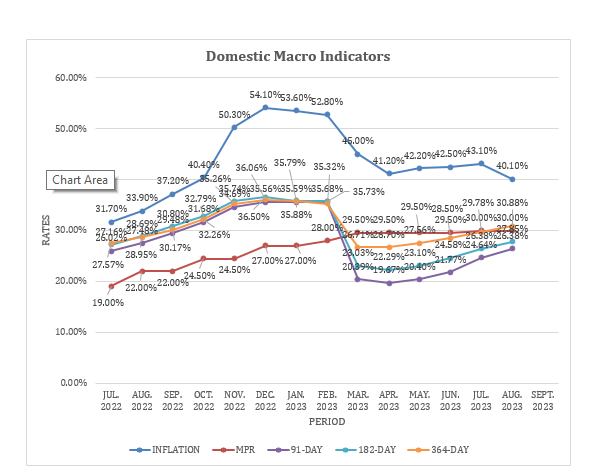Short-term yields on the Treasury remain high due to government’s over-reliance on T-bills. This is further compounded by elevated inflation and the resultant monetary policy to combat rising prices.
Recent data from auctions held on September 8, 2023 reveal that the 364-day T-bill had reached a disconcerting 32 percent interest rate, while the 91-day T-bill is just a hair’s-breadth under 30 percent. This reflects government’s limited options, high borrowing costs and lingering threat to debt sustainability.
Investors are demanding higher yields at T-bill auctions due to elevated inflation risks, low real returns on fixed-income investments and market uncertainties. This demand has partly offset the interest savings achieved by reducing T-bill yields post-Domestic Debt Exchange Programme (DDEP).
Government’s strategy to reduce yields after the DDEP led to a 17 percent drop in the 91-day T-bill rate from 35.75 percent pre-DDEP to 18.53 percent by March 20, 2023. However, yields have risen since April due to continued money market borrowing and limited external funding. Investors seek compensation for economic uncertainties, leading to T-bill clearing yields ranging from 27.8 percent to 32 percent.
In recent Treasury auctions, yields increased further – with the 91-day, 182-day and 364-day bills settling at 27.79 percent, 29.12 percent and 31.97 percent respectively. These rates have surged since start of first-quarter 2023, with the 91-day bill increasing by 840 basis points (bps), while the 182-day and 364-day bills rose by 768 bps and 631 bps respectively.
These T-bill yields now exceed the coupon rates on restructured bonds. The tight monetary stance may continue to push yields higher until government secures concessional funding alternatives.
In August 2023 government faced rising borrowing costs, with the 91-day bill increasing by 178 bps to 27.02 percent, the 182-day bill by 147 bps to 28.62 percent and the 364-day bill by 93 bps to 31.24 percent. The Treasury successfully sold GH¢12.35billion worth of bills to cover GH¢10.18billion in maturing bills, resulting in a maturing cover of 1.21x.
Government aims to raise GH¢3.76billion in the upcoming auction on September 15, 2023, highlighting its ongoing need for funds. With policy rates at 30 percent amid the elevated inflationary pressures, higher Treasury rates are expected to remain in the near-term.
The escalating borrowing costs burden government’s already strained fiscal position, making it challenging to manage existing debt and fulfil future financial commitments.
Monetary response to inflation
In response to emerging inflation risks, the Bank of Ghana’s Monetary Policy Committee (MPC) has adopted a tighter monetary stance. This move will significantly impact Treasury securities, particularly 91-day to 364-day T-bills, as they face an extended period of higher yields.
During its July 2023 policy meeting, the MPC increased the policy rate by 50 basis points (bps) to 30 percent in an effort to counter inflation risks and address the need for substantial tightening in both fiscal and monetary policy frameworks.
Inasmuch as inflation retreated to 40.1 percent in August 2023, it still remains elevated – with only Sierra Leone (44.98 percent), Sudan (63.3 percent) and Zimbabwe (77.2 percent) higher, with next-door neighbours Côte d’Ivoire and Togo at 4.6 and 3.8 percent respectively.
Despite endeavours to restructure the country’s debt portfolio, the updated public debt stock -excluding debt from state-owned enterprises and special purpose vehicles (SOE/SPVs) – shows significant growth, primarily due to an increasing domestic debt burden and earlier exchange rate movements.
According to the Bank of Ghana’s summary of macroeconomic and financial data published in July 2023, the total debt stock increased by 21.3 percent from December 2022 to GH¢569.3billion (71.1 percent of GDP) in April 2023. The domestic debt component rose by 6.29 percent – GH¢15.6billion – reaching GH¢247.9billion (30.95 percent of GDP); while external debt in cedi terms surged by 33.41 percent – GH¢80.5billion – reaching GH¢321.4billion (40.13 percent of GDP).
Government’s ongoing struggle to manage surging borrowing costs – amid inflationary pressures and a tighter monetary policy rate – underscores the challenges facing fiscal and economic stability. With the likelihood of even higher yields on the horizon, government faces an uphill battle to navigate these turbulent financial waters.
Looking forward, the market anticipates that yields on Treasury bills will continue to rise, although at a slower pace, as the Treasury adjusts its bids in response to persistent demand pressures.










